High Impact Tutoring Built By Math Experts
Personalized standards-aligned one-on-one math tutoring for schools and districts
In order to access this I need to be confident with:
Least common factor
Simplifying fractions Adding and subtracting fractions Multiplying and dividing fractionsSolving equations with fractions
Solving equations How to factor quadratic equationsRational function
Here you will learn about rational functions, including how to simplify rational functions and operations with rational functions.
Students first learn about rational functions in Algebra 1 and expand their knowledge as they progress through high school math.
What are rational functions?
Rational functions or algebraic fractions, are functions that are fractions because they have a numerator and denominator. Rational functions are expressed as the ratio of two polynomials such that the denominator is not equal to 0.
R(x)=\cfrac{p(x)}{q(x)} where q(x)
Rational functions contain at least one variable. They also have denominators and numerators that can be linear functions, quadratic functions, or any polynomial function.
Here are the three types of rational functions and the graph of the functions
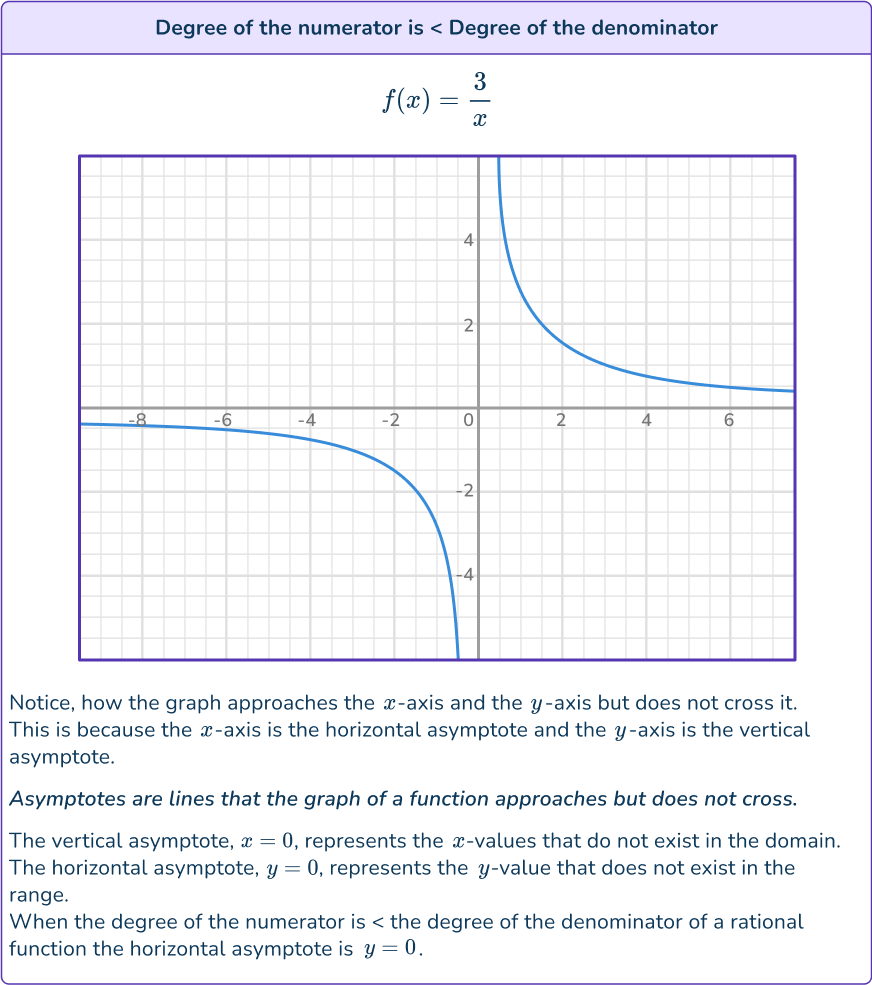
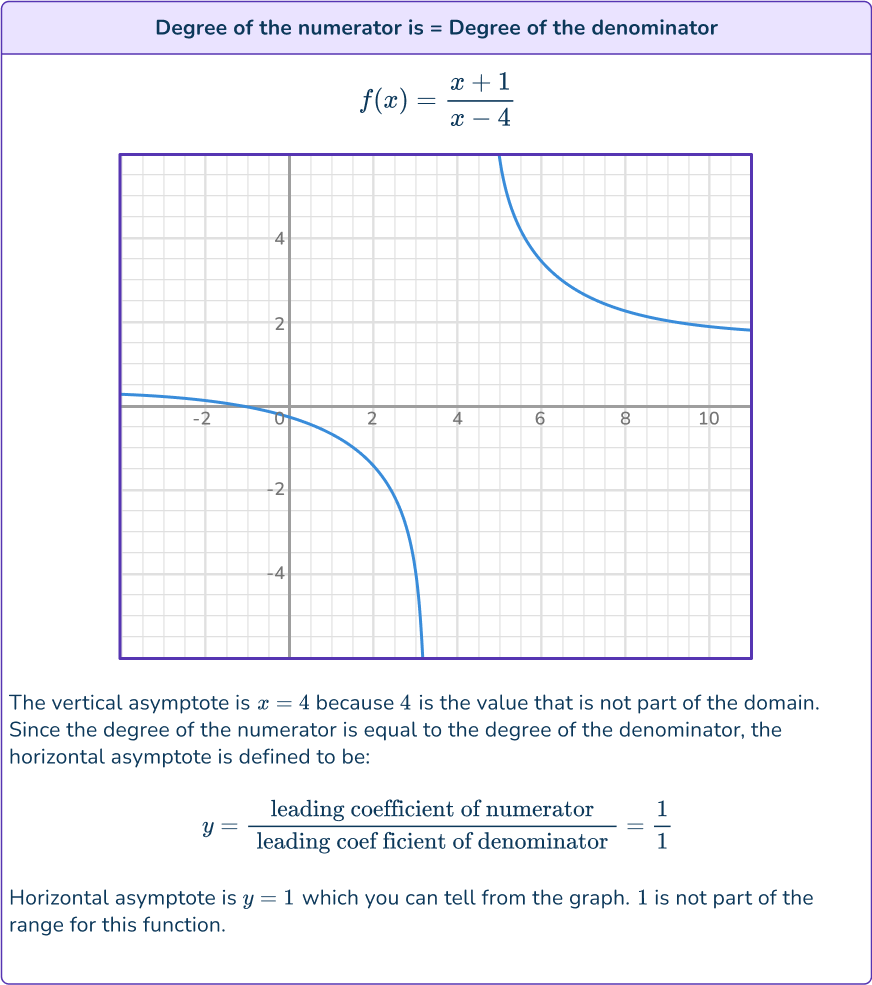
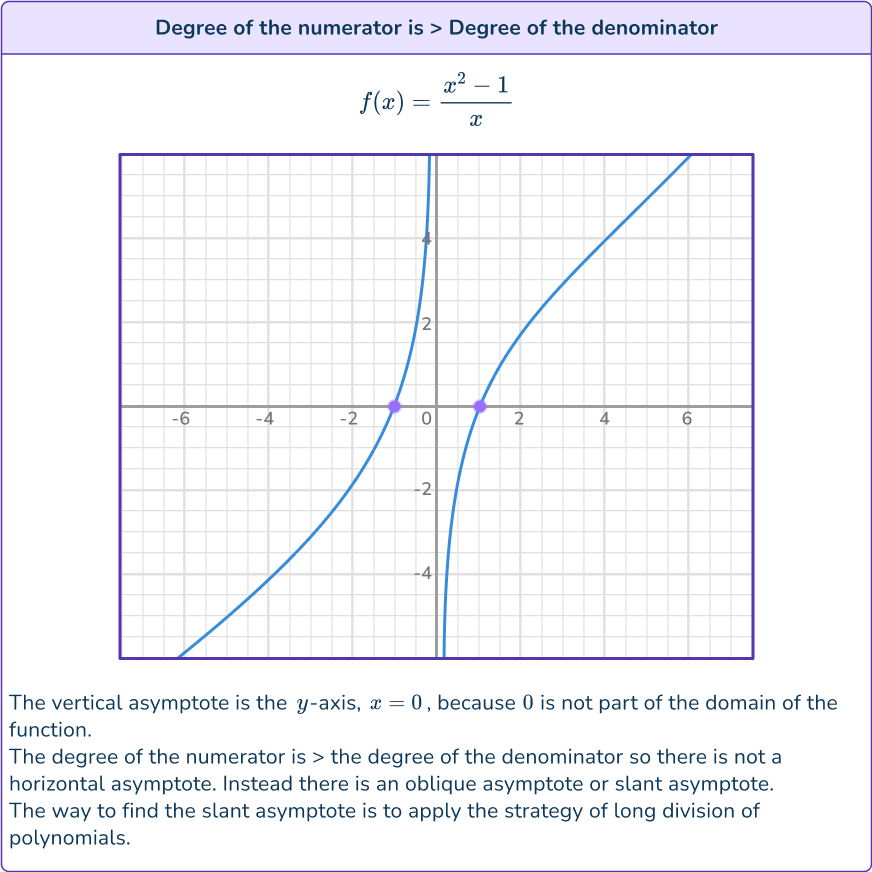
![[FREE] Algebra Worksheet (Grade 6 to 8)](https://thirdspacelearning.com/wp-content/uploads/2023/07/Algebra-check-for-understanding-quiz-listing-image-.png)
[FREE] Algebra Worksheet (Grade 6 to 8)
![[FREE] Algebra Worksheet (Grade 6 to 8)](https://thirdspacelearning.com/wp-content/uploads/2023/07/Algebra-check-for-understanding-quiz-listing-image-.png)
Use this quiz to check your grade 6 to 8 students’ understanding of algebra. 10+ questions with answers covering a range of 6th and 8th grade algebra topics to identify areas of strength and support!
DOWNLOAD FREE![[FREE] Algebra Worksheet (Grade 6 to 8)](https://thirdspacelearning.com/wp-content/uploads/2023/07/Algebra-check-for-understanding-quiz-listing-image-.png)
[FREE] Algebra Worksheet (Grade 6 to 8)
![[FREE] Algebra Worksheet (Grade 6 to 8)](https://thirdspacelearning.com/wp-content/uploads/2023/07/Algebra-check-for-understanding-quiz-listing-image-.png)
Use this quiz to check your grade 6 to 8 students’ understanding of algebra. 10+ questions with answers covering a range of 6th and 8th grade algebra topics to identify areas of strength and support!
DOWNLOAD FREESimplifying rational functions is a necessary skill when applying operations to rational functions.
Let’s look at a few examples of how to simplify rational functions.
Remember when you learned how to simplify fractions in elementary school?
For example, if you have the fraction, \cfrac{7}{21}, you look to see if it can be simplified by determining if there are any common factors of the numerator and the denominator.
In this case, there is a common factor of 7 for both the numerator and denominator.
\cfrac{7}{21}=\cfrac{7}{7 \times 3}=\cfrac{1}{3}In order to simplify algebraic fractions or rational functions you will use a similar strategy. Look for a common factor to the numerator and the denominator.
Let’s simplify:
\cfrac{15 x^2}{30 x}First, find the common factor between the numerator and the denominator.
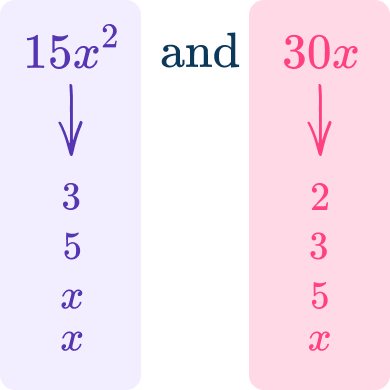
Looking at the factors for both expressions, 3, 5, and x are the common factors.
3 \times 5 \times x=15 x15x is the common factor.

If you want to learn more on how to simplify rational functions, go to:
Step-by-step guide: Simplifying rational expressions
Adding and subtracting rational expressions
Rational expressions can be added and subtracted. Similar to adding and subtracting fractions, rational expressions need a common denominator before they can be added or subtracted.
Let’s add the rational functions:
\cfrac{4}{24 x y}+\cfrac{10}{6 y^2}Before the expressions can be added together, first you will need to find the common denominator.
The two denominators are:
24 x y \quad 6 y^2Looking at the coefficients, the least common multiple of 24 and 6 is 24.
To find the least common multiple of the variables, xy and y^2, you need to look at each variable and take the variable to the higher exponent.
x has to be included in the least common denominator because it is the variable to the highest exponent (x^1 has a higher exponent than x^0)
\text { Remember } x^0=1 \text { meaning that } 6 y^2 \text { has } x^0y^2 has to be included in the least common denominator because y^2 has a higher exponent than y^1.
So the least common denominator of \cfrac{4}{24 x y}+\cfrac{10}{6y^2} is 24 x y^2.
Now, you will have to adjust each rational expression so that it has a denominator of 24 x y^2. Be sure to multiply the numerator and denominator by the missing factors.
\begin{aligned}& \cfrac{4}{24 x y} \times \cfrac{y}{y}=\cfrac{4 y}{24 x y^2} \\\\ & \cfrac{10}{6 y^2} \times \cfrac{4 x}{4 x}=\cfrac{40 x}{24 x y^2} \end{aligned}After adjusting both rational expressions to have a common denominator, you can add them.
\cfrac{4 y}{24 x y^2}+\cfrac{40 x}{24 x y^2}=\cfrac{4 y+40 x}{24 x y^2} \rightarrow The rational expression can be written as one expression.
The numerators cannot be simplified any further because they are not like terms.
If you want to learn more about adding and subtracting rational functions, go to:
Step-by-step guide: Adding and subtracting rational expressions
Multiplying and dividing rational expressions
Rational expressions can be multiplied and divided. Similar to multiplying and dividing fractions, rational expressions do not need a common denominator to be multiplied or divided. The product or quotient should be fully simplified.
Let’s multiply the rational expressions.
\cfrac{(x-4)}{\left(x^2+8 x+15\right)} \times \cfrac{(x+5)^2}{\left(x^2-16\right)}Before multiplying, factor any expression that can be factored.
In this case, the denominators of both expressions can be factored.
\begin{aligned}& \cfrac{(x-4)}{\left(x^2+8 x+15\right)} \times \cfrac{(x+5)^2}{\left(x^2-16\right)} \\\\ & \cfrac{(x-4)}{(x+3)(x+5)} \times \cfrac{(x+5)^2}{(x-4)(x+4)} \\\\ & \cfrac{(x-4)}{(x+3)(x+5)} \times \cfrac{(x+5)(x+5)}{(x-4)(x+4)} \end{aligned}When multiplying or dividing, look to cancel any matching expressions as long as they are placed in opposite positions, (one in the numerator and one in the denominator)

The rational expressions can now be multiplied, meaning they can be written as one rational expression.
\cfrac{(x-4)(x+5)}{(x+3)(x+4)}=\cfrac{x^2+x-20}{x^2+7 x+12}If you want to learn more about how to multiply and divide rational expressions, go to:
Step-by-step guide: Multiplying rational expressions
Solving rational equations
The strategy to solve rational equations is similar to the strategy used to solve equations with fractions in them.
Let’s solve the rational equation,
\cfrac{1}{x}+\cfrac{3}{2 x}=6First, find the common denominator, in this case, the common denominator is 2x.
Multiply the equation by the common denominator, 2x.
\begin{aligned}& 2 x\left(\cfrac{1}{x}+\cfrac{3}{2 x}=6\right) \\\\ & 2 x \times \cfrac{1}{x}=\cfrac{2 x}{x}=2 \\\\ & 2 x \times \cfrac{3}{2 x}=\cfrac{6 x}{2 x}=3 \\\\ & 2 x \times 6=12 x \end{aligned}The new equation after multiplying by 2x is:
2+3=12 xSolving for x\text{:}
\begin{aligned}& 2+3=12 x \\\\ & 5=12 x \\\\ & \cfrac{5}{12}=\cfrac{12 x}{12} \\\\ & \cfrac{5}{12}=x \end{aligned}Check the solution to make sure that 0 is not in the denominator.
\begin{aligned}& \cfrac{1}{x}+\cfrac{3}{2 x}=6 \\\\ & \cfrac{1}{\cfrac{5}{12}}+\cfrac{3}{2\left(\cfrac{5}{12}\right)}=6 \\\\ & \cfrac{12}{5}+\cfrac{3}{\cfrac{10}{12}}=6 \\\\ & \cfrac{12}{5}+\cfrac{12}{10}\left(\cfrac{3}{1}\right)=6 \\\\ & \cfrac{12}{5}+\cfrac{36}{10}=6 \\\\ & \cfrac{24}{10}+\cfrac{36}{10}=6 \\\\ & \cfrac{60}{10}=6 \; ✅\end{aligned}What are rational functions?
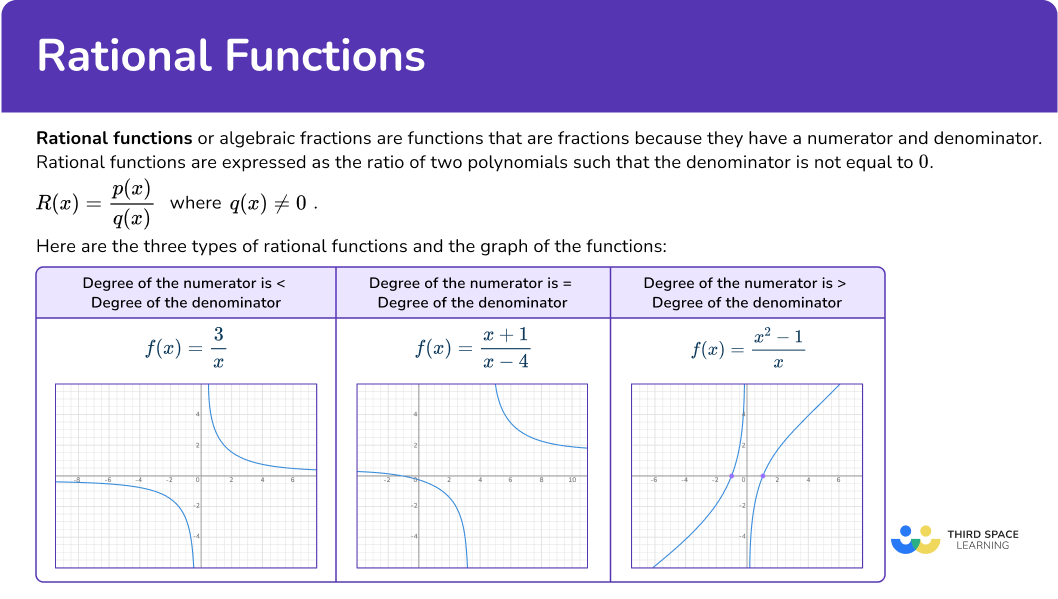
Common Core State Standards
How does this relate to high school math?
- High School Algebra: Arithmetic with Polynomials and Rational Expressions (HSA-APR.D.6)
Rewrite simple rational expressions in different forms; write \cfrac{a(x)}{b(x)} in the form q(x)+ \cfrac{r(x)}{b(x)}, where a(x), b(x), q(x), and r(x) are polynomials with the degree of r(x) less than the degree of b(x), using inspection, long division, or, for the more complicated examples, a computer algebra system.
- High School Algebra: Arithmetic with Polynomials and Rational Expressions (HSA-APR.D.7)
Understand that rational expressions form a system analogous to the rational numbers, closed under addition, subtraction, multiplication, and division by a nonzero rational expression; add, subtract, multiply, and divide rational expressions.
How to simplify and apply operations to rational functions
If you want more detailed steps and practice for simplifying rational expressions and applying the operations to rational expressions, check out the links highlighted above or take a look at the examples below.
Simplify and apply operations of rational functions examples
Example 1: simplify rational expressions without factoring
Simplify the expression: \cfrac{28 x^2 y}{7 x y^2} .
- Identify the greatest common factor of the numerator and the denominator.
The numerator, 28 x^2 y and the denominator, 7 x y^2 have a greatest common factor of, 7 x y.
Looking at the coefficients of 28 and 7, the greatest common factor between those numbers is 7.
Looking at the variable x, the greatest common factor between x^2 and x is x.
Lastly, looking at the variable y, the greatest common factor between y and y^2 is y.
So, the greatest common factor between 28 x^2 y and 7 x y^2 is 7 x y.
2Simplify the expression by the greatest common factor.
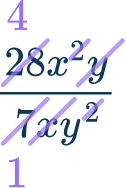
3Write the simplified expression.
\cfrac{28 x^2 y}{7 x y^2}=\cfrac{4 x}{y}Example 2: subtracting rational expressions by factoring
Subtract the rational expressions, \cfrac{8}{(x-2)}-\cfrac{9}{\left(x^2-4\right)} .
If possible, factor the denominators before finding the least common denominator.
(x-2) \rightarrow Cannot be factored
\left(x^2-4\right) \rightarrow Can be factored because it the difference of two perfect squares.
Applying the strategy of factoring the difference between two perfect squares, \left(x^2-4\right) factors to be (x+2)(x-2).
Find the least common denominator.
After factoring,
\cfrac{8}{(x-2)}-\cfrac{9}{\left(x^2-4\right)}=\cfrac{8}{(x-2)}-\cfrac{9}{(x+2)(x-2)}
Looking at the factored expression, the denominators are:
So, the least common denominator is (x+2)(x-2), take one of each factor to get the common denominator.
Adjust the rational expressions to have the common denominator.
Subtract and simplify the rational expression.
\cfrac{8 x+7}{(x+2)(x-2)} \rightarrow The difference cannot be simplified further, but the denominator can be multiplied back out.
\cfrac{8 x+7}{(x+2)(x-2)}=\cfrac{8 x+7}{\left(x^2-4\right)}
Example 3: multiplying without factoring
Multiply the rational expressions: \cfrac{8 a}{14 b^2} \times \cfrac{7 b^3}{20 a^2} .
Factor the expression if possible.
The expression cannot be factored.
Simplify the expression before multiplying.
In this case, 7 and 14 can simplify by a common factor of 7; b^2 and b^3 simplify by a common factor of b^2.
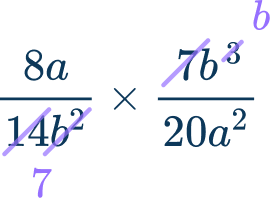
Also, 8 and 20 can simplify by a factor of 4; a and a^2 can simplify by a factor of a.
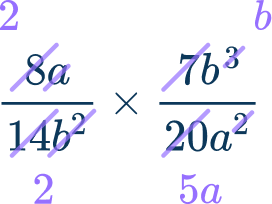
Multiply the expressions and simplify the product if necessary.
\cfrac{2}{2} \times \cfrac{b}{5 a}=\cfrac{2 b}{10 a} \rightarrow The product can be simplified further because 2 and 10 have a common factor of 2.
So, \cfrac{2 b}{10 a}=\cfrac{b}{5 a}
Example 4: divide rational expressions with factoring
Divide the rational functions, \cfrac{5}{\left(x^2+5 x+6\right)} \div \cfrac{4}{\left(x^2+6 x+9\right)} .
Factor the expression if possible.
The denominators of both rational expressions can be factored.
With division, take the reciprocal of the second expression and change the operation to multiplication.
The reciprocal of \cfrac{4}{(x+3)(x+3)} is \cfrac{(x+3)(x+3)}{4}
The new expression is:
\cfrac{5}{(x+2)(x+3)} \times \cfrac{(x+3)(x+3)}{4}
Simplify before multiplying.
Look for common factors to cancel.

The only common factor was x+3 .
Multiply the expressions and simplify the answer if possible.
You can leave the answer as \cfrac{5(x+3)}{4(x+2)} or apply the distributive property, \cfrac{5 x+3}{4 x+8}
How to solve rational equations
In order to solve rational equations:
- Find the common denominator of all the rational expressions in the equation.
- Multiply the entire equation by the common denominator.
- Solve the equation.
- Check the solution
Solve rational equation examples
Example 5: equation with x in the denominator
Solve the equation:
\cfrac{5}{2 x}-\cfrac{14}{x}=3Find the common denominator of all the rational expressions in the equation.
The denominators are 2x , x and 1 (whole numbers have a denominator of 1 ).
The common denominator which is also the least common multiple of all expressions, is 2x.
Multiply the entire equation by the common denominator.
2 x\left(\cfrac{5}{2x}-\cfrac{14}{x}=3\right)

Solve the equation.
After multiplying by 2x, the new equation is:
Check the solution.
Substitute \cfrac{- \, 23}{6} for x into the original equation.
Example 6: distributing binomials
\cfrac{x+1}{x+2}+\cfrac{3}{x-4}=1Find the common denominator of all the rational expressions in the equation.
The denominators are: (x+2), (x-4), and 1
The common denominator is (x+2)(x-4) .
Multiply the entire equation by the common denominator.
(x+2)(x-4)\left[\cfrac{x+1}{x+2}+\cfrac{3}{x-4}=1\right]

(x+2)(x-4)(1)=(x+2)(x-4)=x^2-2 x-8
Solve the equation.
After multiplying by the common denominator, (x+2)(x-4) the equation is:
Check the solution
Substitute 5 for x into the original equation.
Teaching tips for rational functions
- Make connections between operations with fractions to operations with rational functions so that students can develop understanding.
- Use active learning activities such as scavenger hunts or game playing to have students review skills instead of giving them a worksheet.
- Encourage students who are struggling to use digital platforms such as Khan Academy so they can view tutorial videos.
Easy mistakes to make
- Multiplying the numerator and the denominator by the common denominator
When solving rational equations, you have to multiply the entire equation by the common denominator. For example,
\cfrac{3}{2x}-\cfrac{1}{5x}=11
The common denominator is 10x, so multiply the entire equation by 10x.
10 x\left(\cfrac{3}{2 x}-\cfrac{1}{5 x}=11\right), when performing this multiplication,
10 x \times \cfrac{3}{2 x}≠ \cfrac{30 x}{20 x} it should be 10 x \times \cfrac{3}{2 x}=15
So then, 10 x \times \cfrac{1}{5 x}=2 and 10 x \times 11=110 x
- Not multiplying all terms by the denominator
When multiplying the equation by the common denominator, be sure to multiply every term.
\begin{aligned}& 3-\cfrac{5}{x-1}=1 \\\\ & (x-1)\left[3-\cfrac{5}{x-1}=1\right] \end{aligned}
3(x-1)-5=1 \rightarrow The last term was not multiplied by (x-1)
So, it should be, 3(x-1)-5=x-1 .
- Adding rational expressions incorrectly
For example, thinking that you should add the numerators and the denominators,
\cfrac{8}{4 x}+\cfrac{7}{x}≠ \cfrac{15}{5 x}
In order to add them, you must find a common denominator just like when you add fractions. In this case, the common denominator is 4x.
\begin{aligned}& \cfrac{8}{4 x}+\cfrac{4}{4} \times \cfrac{7}{x}= \\\\ & \cfrac{8}{4 x}+\cfrac{28}{4 x}=\cfrac{36}{4 x} \end{aligned}
The answer can be simplified further to be, \cfrac{36}{4 x}=\cfrac{9}{x} .
Practice rational functions questions
1. Simplify the rational expression: \cfrac{(x+7)}{\left(x^2+9 x+14\right)}




Factor the numerator and denominator before simplifying.
The numerator cannot be factored in this case, but the denominator can be factored.
\cfrac{(x+7)}{\left(x^2+9 x+14\right)}=\cfrac{x+7}{(x+7)(x+2)}
After factoring, cancel the terms in the numerator that are the same as the terms in the denominator.

The simplified expression is: \cfrac{1}{x+2} Remember that there is a 1 in the numerator because \cfrac{x+7}{x+7}=\cfrac{1}{1}
2. Add the expression:
\cfrac{6}{(x+2)}+\cfrac{9}{(x-1)}




In order to add rational functions, you have to find the common denominator.
The common denominator of \cfrac{6}{(x+2)}+\cfrac{9}{(x-1)} is (x+2)(x-1)
Multiply the numerator and denominator by the common denominator.
\begin{aligned}&\cfrac{(x+2)(x-1)}{(x+2)(x-1)}\left(\cfrac{6}{x+2}\right)=\cfrac{6(x-1)}{(x+2)(x-1)} \\\\ & \cfrac{(x+2)(x-1)}{(x+2)(x-1)}\left(\cfrac{9}{x-1}\right)=\cfrac{9(x+2)}{(x+2)(x-1)} \end{aligned}
\cfrac{6(x-1)}{(x+2)(x-1)}+\cfrac{9(x+2)}{(x+2)(x-1)}=\cfrac{6(x-1)+9(x+2)}{(x+2)(x-1)}=\cfrac{6 x-6+9 x+18}{(x+2)(x-1)}=\cfrac{15 x+12}{(x+2)(x-1)}
3. Multiply the expression:
\cfrac{6 y^4}{5 x} \times \cfrac{25 x^3}{y^2}




You can either simplify first and then multiply or multiply first and then simplify. In this case, let’s simplify first:
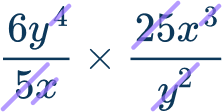
\cfrac{6 y^2}{1} \times \cfrac{5 x^2}{1}=\cfrac{30 x^2 y^2}{1}=30 x^2 y^2
4. Divide the rational expression:
\cfrac{5}{(x-8)} \div \cfrac{20}{\left(x^2-64\right)}




When dividing rational expressions, remember to take the reciprocal of the second expression and multiply it to the first.
\cfrac{5}{(x-8)} \div \cfrac{20}{\left(x^2-64\right)}=\cfrac{5}{(x-8)} \times \cfrac{\left(x^2-64\right)}{20}
Before multiplying, factor and simplify the expressions by canceling any terms that match in the numerator with terms in the denominator.
\cfrac{5}{(x-8)} \times \cfrac{(x-8)(x+8)}{20}
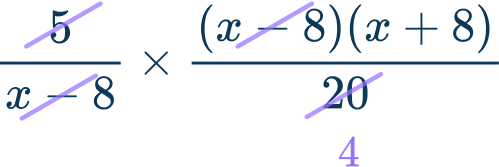
Now, multiply: \cfrac{1}{1} \times \cfrac{(x+8)}{4}=\cfrac{x+8}{4}
5. Solve the equation:
\cfrac{4}{x}+\cfrac{2}{4 x}=- \, 8




Multiply the entire equation by the common denominator.
In this case, the common denominator is 4x.
\begin{aligned}& 4 x\left(\cfrac{4}{x}+\cfrac{2}{4 x}=- \, 8\right) \\\\ & 16+2=- \, 32 x \\\\ & 18=- \, 32 x \\\\ & \cfrac{18}{- \, 32}=\cfrac{- \, 32 x}{- \, 32} \\\\ & – \, \cfrac{18}{32}=x \end{aligned}
Checking the solution, it works in the original equation.
\begin{aligned}& \cfrac{4}{\cfrac{- \, 18}{32}}+\cfrac{2}{4\left(\cfrac{- \, 18}{32}\right)}=- \, 8 \\\\ & 4 \times- \, \cfrac{32}{18}+\cfrac{2}{\cfrac{- \, 18}{8}}=- \, 8 \\\\ & – \, \cfrac{64}{9}+\left(- \, \cfrac{8}{9}\right)=- \, 8 \\\\ & – \, \cfrac{72}{9}=- \, 8 \\\\ & – \, 8=- \, 8 \; ✅ \end{aligned}
6. Solve the equation:
\cfrac{5}{x}+\cfrac{2x}{5}=3\
x=2.5 or x=5




Find the common denominator of the equation and multiply the entire equation by the common denominator. In this case, the common denominator is 5x.
\begin{aligned}& 5 x\left(\cfrac{5}{x}+\cfrac{2 x}{5}=3\right) \\\\ & 5 x \times \cfrac{5}{x}=25 \\\\ & 5 x \times \cfrac{2 x}{5}=2 x^2 \\\\ & 5 x \times 3=15 x \end{aligned}
After multiplying, the new equation is quadratic.
25+2 x^2=15 x
Solve the quadratic by first setting the quadratic equation equal to 0 and then using factoring or the quadratic formula to solve.
If you need extra help with solving quadratic equations, check out these links.
How to factor quadratic equations
\begin{aligned} &\begin{aligned}& 25+2 x^2-15 x=15 x-15 x \\\\ & 25+2 x^2-15 x=0 \\\\ & 2 x^2-15 x+25=0 \\\\ & (2 x-5)(x-5)=0 \\\\ & (2 x-5)=0 \hspace{1.85cm} (x-5)=0 \end{aligned} \\\\ &\begin{aligned}& 2 x-5+5=0+5 \hspace{1cm} x-5+5=0+5\\\\ & 2 x=5 \hspace{2.7cm} x=5 \\\\ & \cfrac{2 x}{2}=\cfrac{5}{2} \\\\ & x=\cfrac{5}{2}=2.5\end{aligned} \end{aligned}
Checking both values, they work in the original equation.
\begin{aligned}& \cfrac{5}{x}+\cfrac{2 x}{5}=3 \\\\ & \cfrac{5}{2.5}+\cfrac{2 \times 2.5}{5}=3 \\\\ & 2+1=3 \; ✅ \\\\ & \cfrac{5}{x}+\cfrac{2 x}{5}=3 \\\\ & \cfrac{5}{5}+\cfrac{2 \times 5}{5}=3 \\\\ & 1+2=3 \; ✅ \end{aligned}
Rational functions FAQs
The asymptotes of rational functions are horizontal lines, vertical lines, or slanted lines that the graph of a rational function approaches but does not cross.
Typically, when sketching the graph of the rational function by hand, the horizontal and vertical asymptotes, as well as the slant asymptotes are noted with a dotted line.
Thinking about the function values that exist in the domain of a rational function and those that do not, helps you find the horizontal and vertical asymptotes.
The values for x that make the denominator equal to 0 are the possible values for the vertical asymptote.
The horizontal asymptote is defined by the ratio of the leading coefficients of the numerator and denominator.
Yes, you can find the inverse functions of rational functions. This concept will be explored in a precalculus course.
You find the x -intercepts and the y -intercepts of rational functions applying the same strategy as you would with any function.
For the x -intercept set the function equal to 0 and find the x values.
For the y -intercept substitute 0 in for the x values and find y. The x and y intercepts are real numbers.
The reciprocal function, f(x)=\cfrac{1}{x} is defined to be the reciprocal function, which is also a rational function.
No, the equation of a circle is not a rational function or even a function at all, it’s considered to be a conic section.
Matrices are a rectangular array of numbers and can be used to solve systems of linear equations.
The next lessons are
- Vectors
Still stuck?
At Third Space Learning, we specialize in helping teachers and school leaders to provide personalized math support for more of their students through high-quality, online one-on-one math tutoring delivered by subject experts.
Each week, our tutors support thousands of students who are at risk of not meeting their grade-level expectations, and help accelerate their progress and boost their confidence.

Find out how we can help your students achieve success with our math tutoring programs.
[FREE] Common Core Practice Tests (3rd to 8th Grade)
Prepare for math tests in your state with these 3rd Grade to 8th Grade practice assessments for Common Core and state equivalents.
Get your 6 multiple choice practice tests with detailed answers to support test prep, created by US math teachers for US math teachers!